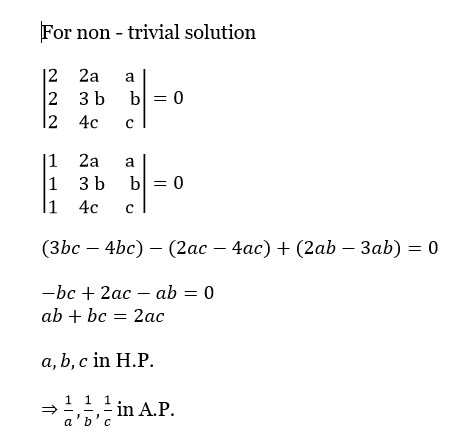Maths Determinants
Get insights from 58 questions on Maths Determinants, answered by students, alumni, and experts. You may also ask and answer any question you like about Maths Determinants
Follow Ask QuestionQuestions
Discussions
Active Users
Followers
New answer posted
2 months agoContributor-Level 10
| 1+x² |
| x 1+x | = − (x - α? ) (x − α? ) (x – α? ) (x – α? )
| x² x 1+x |
Put x = 0
| 1 0 |
| 0 1 0 | = - (-α? ) (-α? ) (-α? ) (-α? )
| 0 1 |
α ⇒? α? α? α? = −1
New answer posted
2 months agoContributor-Level 10
|adj (adj (A)| = |A|? ¹² = |A|?
|A| = | (14, 28, -14), (-14, 28), (25, -14, 14) |
= (14)² | (1, 2, -1), (-1, 2), (25/14, -1, 1) |
= (14)² (3–2 (–5)–1 (–1)
|A|? = (14)? => |A| = 14²
New answer posted
2 months agoContributor-Level 9
(P? ¹AP - I)²
= (P? ¹AP - I) (P? ¹AP - I)
= P? ¹A (PP? ¹)AP - P? ¹AP - P? ¹AP + I
= P? ¹A²P - 2P? ¹AP + I
= P? ¹ (A² - 2A + I)P = P? ¹ (A - I)²P
| (P? ¹AP - I)²| = |P? ¹ (A - I)²P| = |P? ¹| | (A - I)²| |P| = | (A - I)²| = |A - I|²
A - I = [1, 7, w²], [-1, w², 1], [0, -w, -w]
|A - I| = 1 (-w³ + w) - 7 (w) + w² (w) = -w³ + w - 7w + w³ = -6w.
|A - I|² = (-6w)² = 36w².
New answer posted
2 months agoContributor-Level 10
The problem involves a function f (x) defined by a determinant:
f (x) = | sin²x 1+cos²x cos2x |
| 1+sin²x cos²x cos2x |
| sin²x cos²x sin2x |
Applying the row operation R? → R? - R? , we get:
f (x) = | -1 0 |
| 1+sin²x cos²x cos2x |
| sin²x cos²x sin2x |
Expanding the determinant along the first row:
f (x) = -1 (cos²x * sin2x - cos2x * cos²x) - 1 (1+sin²x)sin2x - sin²x * cos2x)
= -cos²x * sin2x + cos2x * cos²x - sin2x - sin²x * sin2x + sin²x * cos2x
= -sin2x (cos²x + sin²x) + cos2x (cos²x + sin²x) - sin2x
= -sin2x + cos2x - sin2x
= cos2x - 2sin2x
To find the maximum value of f (x), we use the form acosθ + bsinθ, where the m
New answer posted
2 months agoContributor-Level 10
For a system of linear homogeneous equations to have a non-trivial solution, the determinant of the coefficient matrix must be zero.
Δ = | 4 λ 2 |
| 2 -1 | = 0
| μ 2 3 |
To simplify, perform the row operation R? → R? - 2R? :
Δ = | 0 λ+2 0 |
| 2 -1 | = 0
| μ 2 3 |
Expand the determinant along the first row:
- (λ+2) * det (| 2 1 |, | μ 3 |) = 0.
- (λ+2) (2*3 - 1*μ) = 0.
(λ+2) (μ-6) = 0.
This implies that either λ+2 = 0 or μ-6 = 0.
So, the conditions are λ = -2 (for any μ) or μ = 6 (for any λ).
New answer posted
2 months agoContributor-Level 10
We need to evaluate the sum:
Σ (100 - r) (100 + r) for r from 0 to 99.
Σ (100² - r²) for r from 0 to 99
= Σ 100² - Σ r² for r from 0 to 99
= 100 * 100² - [99 (99+1) (2*99+1)]/6
= 100³ - [99 * 100 * 199]/6
= 100³ - (1650 * 199)
Comparing this with (100)³ – 199β, we get:
β = 1650
If we consider a comparison form α = 3β, this part of the solution seems to have a typo, but based on the final calculation, Slope = α/β = 1650 / 3 = 550 seems to be intended.
Taking an Exam? Selecting a College?
Get authentic answers from experts, students and alumni that you won't find anywhere else
Sign Up on ShikshaOn Shiksha, get access to
- 65k Colleges
- 1.2k Exams
- 679k Reviews
- 1800k Answers

